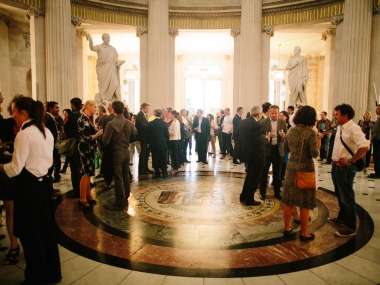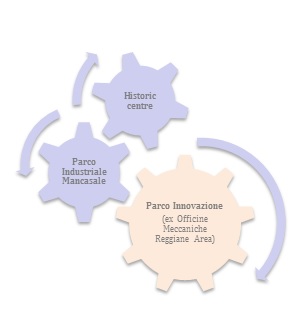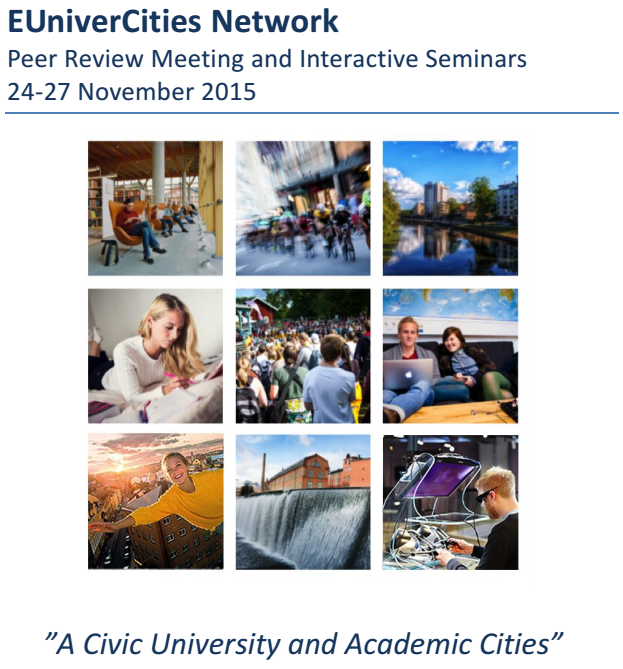Urban Development Network peer review: Economic challenges and the case of Reggio Emilia
Edited on
28 October 2019One of the key aims of the EU Urban Agenda is to foster better knowledge exchange. URBACT and the newly created Urban Development Network (UDN) have a vital role to play to help cities to be better informed and inspired about the policy solutions available.

In January this year a pilot peer review workshop took place aiming to support cities with their Integrated Sustainable Urban Development Strategies[1] in line with ERDF Article 7. It was hosted by the UDN and attended by 60 urban professionals from 30 different cities. During the workshop Seville, Brno, Reggio Emilia, and Rotterdam presented their strategies for open discussion and feedback by peer cities as well as experts. Each city under review was asked to identify specific questions they thought were relevant to be discussed among their peers.
"The Urban Development Network workshop allowed participating cities to meet their peers, European Commission staff, experts and others to discuss common issues and challenges related to their current work on Integrated Sustainable Urban Development Strategies foreseen in Art.7 of ERDF Regulation. Participants gained first-hand evaluation experience and the four presenting cities are now using the peer review outcomes to further improve their strategies. We hope this type of exchange within the Urban Development Network can help to create a community of practice in an open and trusted learning environment."
Fiona Wieland, DG Regional and Urban Policy, European Commission

This article summarises the discussions arising from the question raised by Reggio Emilia, a medium sized city in Northern Italy, relating to economic development. The challenges they described will resonate for many European cities and the knowledge generated in the workshop can hopefully inspire other cities and URBACT networks.
It is really interesting to get confirmation that other cities are facing the same challenges… We can go back home being sure we are following the right path.
Participant
The Case of Reggio Emilia
Reggio Emilia presented its Urban Development Strategy which is part of the overall European Regional Development Fund Operational Programme for the Emilia Romagna Region. The overall strategic vision is to transform the city from a production economy to a knowledge economy by enhancing social innovation, creativity and territorial attractiveness.
The Action Plan embedded in the Strategy includes three elements aiming to develop Reggio Emilia:
- as a centre for research and development, technology transfer and high specialisation, through the regeneration of a disused industrial area and turn it into a hub for industrial research and knowledge transfer (Parco dell’Innovazine);
- as a national centre of manufacturing through a project in the northern area of the city (the Parco Industriale);
- as a hub for new entrepreneurs in the fields of culture, social innovation, social services and ICT, through new Open Labs in a restored San Pietro (previously a Benedictine monastery);
 The city conducted a detailed analysis, based on the Smart Specialisation Strategies methodology to inform the Action Plan. This exercise pinpointed a number of distinctive sector strengths: personal services, childcare and education, culture, mechatronics, food, energy, and environment. It also highlighted some of the city's distinctive values such as the entrepreneurial culture, participation and solidarity. These sectoral and socio-cultural strengths will be combined in order to focus innovation, attract investment, and respond to socio-economic challenges.
The city conducted a detailed analysis, based on the Smart Specialisation Strategies methodology to inform the Action Plan. This exercise pinpointed a number of distinctive sector strengths: personal services, childcare and education, culture, mechatronics, food, energy, and environment. It also highlighted some of the city's distinctive values such as the entrepreneurial culture, participation and solidarity. These sectoral and socio-cultural strengths will be combined in order to focus innovation, attract investment, and respond to socio-economic challenges.
The specific question posed for the peer review was: How can the city reconcile investment in innovation in the cultural and creative industries and social innovation with the need to ensure economic feasibility in the medium to long term?
The challenge, common for many local authorities, relates to how best to target public sector investment in new forms of economic development, to ensure the best return in terms of high value job creation, social innovation, and business start-up. The city needs to retain and improve competitiveness in the face of globalisation, cheaper labour elsewhere, and potential loss of production jobs. In order to transform the economy, the local authority will invest ERDF in start-up spaces and incubator activity, focusing particularly on the priority sectors identified. It needs to develop policies and processes with the best chance of medium to long term success for activities that are strategic for urban cultural and social development, but are not always capable of attracting huge capital.
The local authority previously supported the creation of a Techno-pole but found that it did not engage with the public and its neighbourhood. The city wants to learn lessons to overcome the ‘silo’ behaviour in university and public administration cultures and in single discipline research teams, to create more synergy and spill overs. Even with its good transport links, including the high speed train to Bologna and Milan, the city still faces the problem of talent moving out of Reggio Emilia to opportunities in larger cities.
Peer Discussions
In response to the challenges presented a wide ranging discussion followed covering a number of associated questions: How can the city attract capital? How can investment best be targeted to underpin business growth and attract private capital into the local economy and new knowledge and cultural activities? How can the city avoid investing in failure but rather pick winners? What kind of support will help businesses and social innovations grow?
Peer cities also shared their own experiences.
 In Warsaw a start-up space and incubator was established by the public administration using ERDF, but the European procurement rules meant it was a very slow process, and in the meantime the private sector quickly set up spaces of its own, including Google campus, which now co-exist with the public sector offer. The rigidity of public procedures was one of the threats already identified by Reggio Emilia in its SWOT analysis. It raises the question of who has the best expertise and approach to attract business start-ups, offer support, and manage incubators. These initiatives can effectively be private, public or partnership-led. The example of the Impact HUB global network was given. It has a good track record in managing and animating co-working spaces, with additional business support, including for sector specialisms such as cultural industries or social innovation, often in cooperation with local government. There is already an Impact HUB in Reggio Emilia and one in Milan. Bristol gave an example of opportunities arising from open data. Releasing public data for instance on mobility, air quality, and food services can stimulate innovation. Their experience showed that productivity can be improved by contracting out local public sector functions.
In Warsaw a start-up space and incubator was established by the public administration using ERDF, but the European procurement rules meant it was a very slow process, and in the meantime the private sector quickly set up spaces of its own, including Google campus, which now co-exist with the public sector offer. The rigidity of public procedures was one of the threats already identified by Reggio Emilia in its SWOT analysis. It raises the question of who has the best expertise and approach to attract business start-ups, offer support, and manage incubators. These initiatives can effectively be private, public or partnership-led. The example of the Impact HUB global network was given. It has a good track record in managing and animating co-working spaces, with additional business support, including for sector specialisms such as cultural industries or social innovation, often in cooperation with local government. There is already an Impact HUB in Reggio Emilia and one in Milan. Bristol gave an example of opportunities arising from open data. Releasing public data for instance on mobility, air quality, and food services can stimulate innovation. Their experience showed that productivity can be improved by contracting out local public sector functions.
In response to the Techno Pole experience there were comments that, in order to gain the full benefits of a Quadruple Helix innovation ecosystems, work spaces and processes need to be actively managed and serendipity 'orchestrated', so that there are always opportunities for different agencies and actors to meet, network, and do business. Many co-working spaces have full time ‘Community Animators’ to organise events, linkages, and stakeholder engagement that generate spill over and create local supply chains.
The potential controversies of ‘market-isation of culture’ were discussed and held resonance for other cities, especially in Spain. Nevertheless, there are important market opportunities for start-ups to grow tourist and visitor economies around the local cultural offer. Terrassa (ES) told of its experience in producing a local ‘White book of culture’ in a participative project involving all cultural stakeholders. Bristol also gave an example of restoring an old warehouse in a peripheral neighbourhood into a film studio, which has generated new economic activity in creative industries, both for the city and in that particular location.
Finally, the huge growth potential of the digital economy was highlighted. Reggio Emilia could benefit from more exploration of new digital sector opportunities to drive, for instance app, game and online platforms that exploit local specialist knowledge in the education, mobility, and food sectors.
Lessons learned
Perhaps not surprisingly, the peer review discussions revealed that public administrations across Europe have much in common. The role of the municipality is changing. For some the imperative to stimulate economic activity is a new one and one for which the city may not be well equipped, in terms of structures, remits, and skills. Some solutions and directions were proposed for the Reggio Emilia team to consider.
ERDF indicators may need to be enhanced to correctly measure return on investment in the Open Labs. With regular monitoring this could help the local authority understand exactly which start ups and innovations are succeeding and why, and help to continuously adapt the plan for SME growth and social innovation.
The infrastructure and design, not just the idea, of the proposed Open Labs are important. Attention needs to be paid to co-location, accessibility, design, staffing, and animation of the spaces. The Labs could host multi-partner stakeholder collaboration in the form of urban creative and social innovation clusters. Ongoing market research on the economic sectors already identified can help to customise business support for growth. Investment in super-fast Wi-Fi will underpin connectivity for digital platforms.
An OECD study by Rüdiger Ahrend was recommended. It analyses how to balance small and large city growth, to retain skills and talent in smaller cities. In the case of Reggio Emilia it may help to devise strategies to prevent talent outmigration to Milan and further afield.
Finally, in terms of governance levels, there was a consensus that cities need to be inside the process of the new EU Urban Agenda. Cities are drivers of economic growth. The realities discussed in the peer review need to be truly reflected in EC policy.
The Reggio Emilia team identified some of the next steps in response to the peer review recommendations as:
- Promotion of integrated partnership between public sector, private sector and University specialists;
- More exploration of new digital sector opportunities;
- Development of case studies of opportunities from new capital investments in the local area/region;
- Promotion of the “enterprise discovery” process with the stakeholders involved in the project;
"The Reggio Emilia team took home a great experience in terms of "human network", competent contributions and helpful hints in order to develop our urban strategy. We are going to engage with IMPACT Hub, as an "informal stakeholder", in our living laboratory which is going to be established in the refurbished spaces of the previous Benedictine complex and whose project is covered by the ERDF Operational Programme."
Chiara Testoni, architect PhD City Council Reggio Emilia
Results

Source: Peer review approach by EUnivercities network, EUnivercities website
The Urban Development Network workshop confirmed the value of the peer review method in creating opportunities for structured exchange and reflection. It has the potential to enhance the capacity of cities to improve delivery of integrated plans. Previous URBACT networks have adapted the tool in different ways to support transfer and learning. EUnivercities, for instance used a peer review approach for all network meetings and many cities have benefitted from peer reviews to evaluate and improve Integrated Action Plans and urban practices.
The peer-review of Reggio Emilia provided an important example for smaller sized cities, whose success is important for EU polycentric territorial balance. Europe has many medium sized cities and they are important for growth and sustainability. It emphasised the need to focus on improving competitiveness, based on a sound analysis of sector strengths and key assets. In the case of Reggio Emilia, these include quality of life, active citizenship, and strong cultural heritage. The ISUD presented and reviewed aims to bring these assets into play in the city’s efforts to retain and attract talent, as well as continuing to engage citizens in social innovations, and in ways to extend and improve public services and the shared life of the city.
Many of the challenges presented by Reggio Emilia and other cities in the peer review have been or will be addressed by past or ongoing URBACT networks. Creative Spin on creative clusters; ESIMEC on workforce development and enterprise in medium sized cities; Gen Y City on retaining young talent and creating start ups; InFocus on adapting the Smart Specialisation regional tool for urban use; EUnivercities on Triple and Quadruple Helix innovation models; TechTown on the digital economy.
These examples of urban knowledge exchange through URBACT and the UDN can help build capacity of city stakeholders to create and deliver the new EU Urban Agenda.
 Submitted by Sally Kneeshaw on
Submitted by Sally Kneeshaw on



